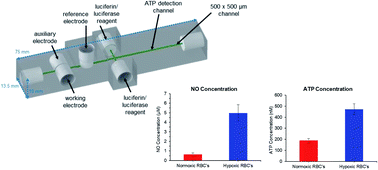A 3D-printed, multi-modal microfluidic device for measuring nitric oxide and ATP release from flowing red blood cells†
Abstract
In this paper, a 3D-printed multi-modal device was designed and fabricated to simultaneously detect nitric oxide (NO) and adenosine triphosphate (ATP) in red blood cell suspensions prepared from whole blood. Once a sample was injected into the device, NO was first detected (via amperometry) using a three-electrode, dual-opposed, electrode configuration with a platinum-black/Nafion coated gold working electrode. After in-line amperometric detection of NO, ATP was detected via a chemiluminescence reaction, with a luciferin/luciferase solution continuously pumped into an integrated mixing T and the resulting light being measured with a PMT underneath the channel. The device was optimized for mixing/reaction conditions, limits of detection (40 nM for NO and 30 nM for ATP), and sensitivity. This device was used to determine the basal (normoxic) levels of NO and ATP in red blood cells, as well as an increase in concentration of both analytes under hypoxic conditions. Finally, the effect of storing red blood cells in a commonly used storage solution was also investigated by monitoring the production of NO and ATP over a three-week storage time.

- This article is part of the themed collection: Analytical Methods HOT Articles 2022


 Please wait while we load your content...
Please wait while we load your content...